
Bigger and Better—But Delayed?
The global pandemic could (eventually) further a consumer thirst for bigger, faster business jets.
In early March of this year, economic tail winds helped propel the business jet industry to its strongest acceleration since the Great Recession, which reduced the number of people and businesses utilizing private air travel. The General Aviation Manufacturers Association reported delivery of 809 business jets in 2019, the highest number in a decade and a 15-percent increase from the previous year. Meanwhile, a new generation of the biggest and best-performing jets were approaching their delivery dates. Those jets, Bombardier’s Global 7500 and Gulfstream’s G700, resulted from a consumer thirst for larger cabins, greater comfort, near-Mach speeds, and transoceanic ranges, as well as the financial confidence to warrant such investments: Those planes list for $73 million and $78 million, respectively, making them the most expensive private jet models on the market.
By late March, the coronavirus pandemic put the global economy on hold and pushed back virtually all new-jet deliveries, in addition to pausing new orders from would-be private jet owners. At press time in June, reports indicated that business aviation, like commercial aviation, would take an enormous financial hit as a result of the pandemic—as would multitudes of assembly line workers, supply chain manufacturers, and service people supporting those industries.
To ease travelers’ concerns, most major flight service providers like NetJets, Flexjet, and VistaJet quickly made gloves and masks available for passengers and adopted stricter practices for cabin sanitation. Flexjet began using its own jets for crew transportation rather than having them fly commercial between legs. Meanwhile, smaller charter providers faced challenges in simply maintaining operations amid widespread shelter-in-place orders and cancellations.
While the private in private air travel has been its biggest selling point, the demand for personal space has never been greater. The Global 7500 and G700 mark the next generation of globe-hopping private jets and, despite delivery delays, are primed to make the world more accessible, and more private, for business aviation consumers.

Bombardier Global 7500
Having been delivered to a small handful of customers late last year, the Global 7500 was on track to reach service providers throughout 2020. Prior to the onset of the pandemic, Bombardier planned 35-plus deliveries, though in late March, the Canadian manufacturer put all production on hold—furloughing more than 12,000 employees at its factory in Quebec, which produces both planes and trains. By May, operations were gradually resuming. A key destination for the aircraft was (and remains) membership-based charter provider VistaJet, which plans to add the Global 7500 to its Bombardier-only fleet in the summer. Fractional provider NetJets also has Global 7500s on order, with planes expected to enter its fleet in 2021.
When VistaJet and NetJets launch the Global 7500, it will bolster their fleets as the most capable private jet in operation: a range of 7,700 nautical miles, enough to reach Hong Kong from Los Angeles; and a maximum speed of 0.925 Mach (as fast as any jet in the sky). Also, surprisingly nimble considering its size, the Global 7500 will be the largest jet operating from smaller airports like London City Airport or Gstaad Saanen Airport in the Swiss Alps, thanks to its landing distance of just 2,500 feet. (This number is closer to that of a regional light aircraft than of a large-cabin international jet.) Bombardier attributes much of this superior performance to a new transonic wing, designed to withstand subsonic and supersonic speeds. With a relatively small surface area, the wing utilizes leading-edge slats and double-slotted inboard flaps, which improve lift and reduce drag.
The wing’s small size maintains a high loading ratio and its structure is considerably more flexible than wings of similarly sized aircraft. A fly-by-wire system actively reduces stress on the wings, making for an exceedingly smooth flight minimally impacted by turbulence.
Furthering the Global 7500’s comfort is its exceptionally spacious cabin. The longest among business jets, its cabin length measures more than 54 feet (about one-third longer than any cabin from Dassault or Gulfstream). Seating configurations accommodate as many as 19 passengers across four living areas, including a private seat with a full-size bed. Bombardier’s proprietary Nuage seats recline, pivot, and swivel to various ergonomic positions, including lying completely flat. There are some 10,000 distinct floor plans available. businessaircraft.bombardier.com
GLOBAL 7500 SPECS
Range: 7,700 Nm
Speed: 0.925 Mach (approx. 710 mph)
Typical Cruise Speed: 0.85 Mach (approx. 652 mph)
Takeoff Distance: 5,800 ft.
Landing Distance: 2,520 ft.
Maximum Seating: 19 passengers
Cabin Dimensions: 6 ft. 2 in. tall – 8 ft. wide – 54 ft. 5 in. long

Gulfstream G700
Early in the pandemic, Gulfstream shut down select buildings at its plant in Savannah, Georgia, and by May was fully operational again. (Textron Aviation, which owns Cessna, announced a rolling furlough of most of its 10,000 workers from its factory in Wichita, Kansas, while Embraer in Brazil furloughed 15,000.) Yet deliveries of the much-anticipated G700 remain set for 2022. (The plane took its maiden flight in February.)
The G700 is likely another win for Gulfstream, considering the huge demand for its previous biggest, fastest, longest-range jet, the G650, launched in 2012. Qatar Airways’ charter service Qatar Executive is set to receive the first G700 as part of its order for 10 of the planes in 2022. The first North American customer for the jet, Flexjet plans to add at least 16 of them to its Red Label fractional fleet (as part of a $1.2 billion order), with the first also scheduled to arrive in 2022.
Building on the success of the G650, Gulfstream added 10 feet to the fuselage to create the G700, which retains many of the same designs, including those for the nose and wings (with new winglets). Beyond its length, the major upgrade is the engines, a pair of Rolls-Royce’s new Pearl 700 turbofans designed specifically for the G700. They add an 8-percent increase in takeoff thrust, a 12-percent better thrust-to-weight ratio, and a 5-percent efficiency improvement. On this larger, heavier platform, the new Rolls-Royce engines maintain the 7,500 nautical-mile range of the extended-range variant of the G650, with a slightly shorter takeoff distance of 6,250 feet.
In terms of one-upmanship, the G700’s cabin is 1 inch taller, 2 inches wider, and 2.5 feet longer than that of the Global 7500, so while the latter can claim the title of longest-range business jet, the former takes the cake for biggest cabin. Filling that exceptionally large cabin with natural light are 20 of Gulfstream’s big and famously oval windows. Like its Bombardier competitor, the G700 seats as many as 19 passengers, though Gulfstream was able to make room for five living spaces (compared to the Global 7500’s four) with only a slightly larger cabin. The G700 is also available in thousands of possible configurations, with enough cabin materials and finishes to fit any personal taste—but those waiting for their personalized G700 may have to wait a little while longer. gulfstream.com
G700 SPECS
Range: 7,500 Nm Speed: 0.925 Mach (approx. 710 mph)
Typical Cruise Speed: 0.85 Mach (approx. 652 mph)
Takeoff Distance: 6,250 ft.
Landing Distance: 3,250 ft.
Maximum Seating: 19 passengers
Cabin Dimensions: 6 ft. 3 in. tall – 8 ft. 2 in. wide – 56 ft. 11 in. long




